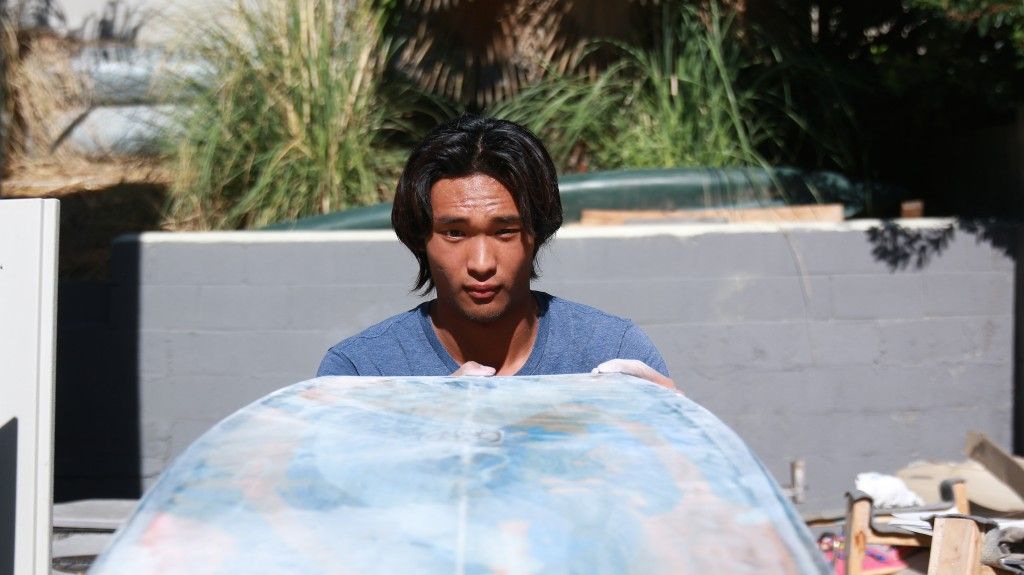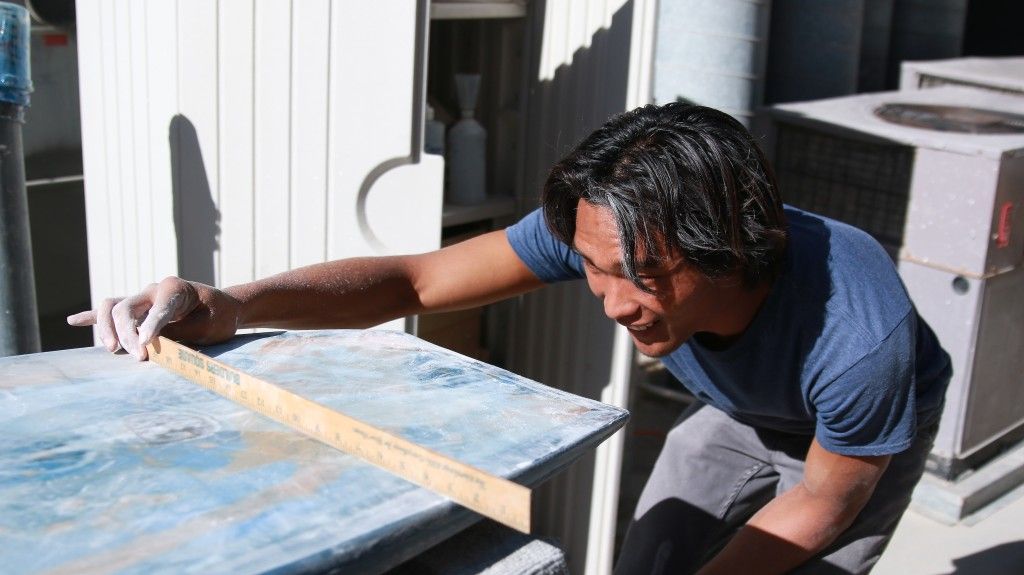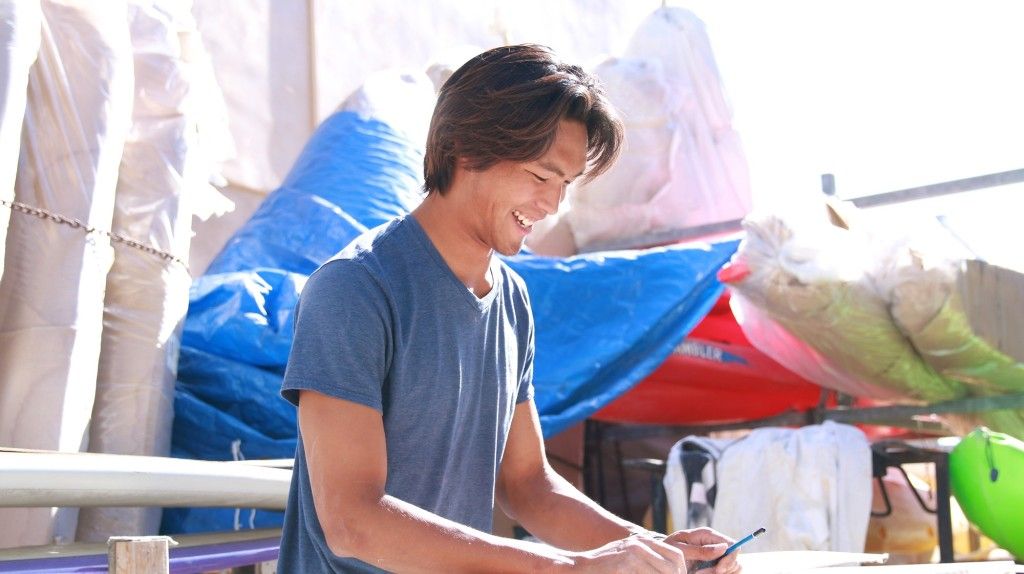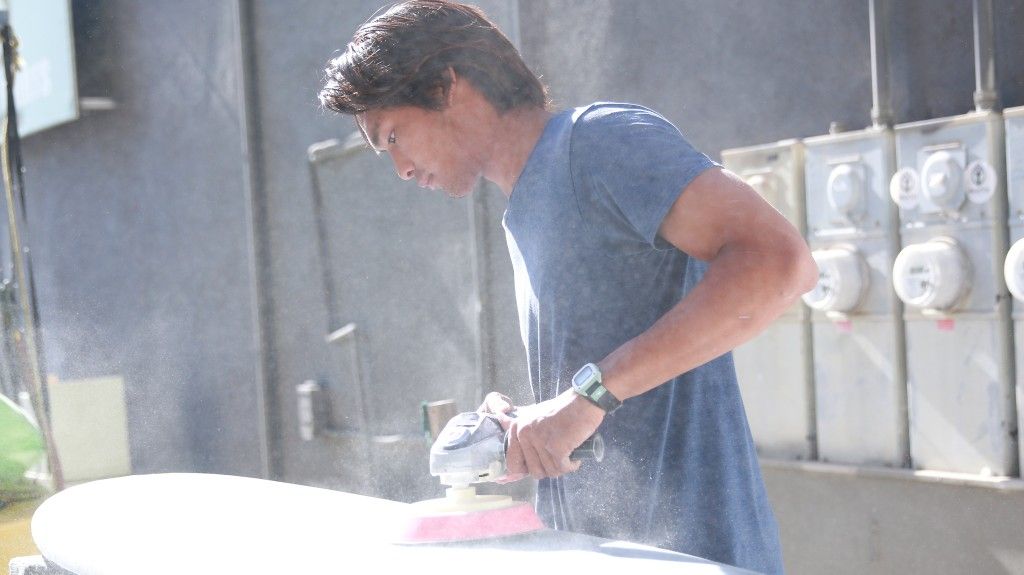Photos by Daniella Romeo
Junior Joseph Ramli grew up in San Diego, but he didn’t start surfing until he came to Pepperdine. Two years into his college career, his passion for all things surf-related has grown into a lifestyle of surfboard shaping that is turning heads and taking him through life with an increased measure of passion.
Ramli’s method of surfboard shaping is both a craft and an art form that involves shaping a material (for him, usually foam, but it can be epoxy, wood, plastic or even cardboard) into any variety of shapes, adding fins or fin boxes, covering it in resin or some other waterproof seal, and sanding it smooth to be waxed up and ridden. “The actual shaping of the board is the romantic part,” Ramli said. “A shaper [understands] how the wave or water will flow around the board, then shapes a ‘blank’ into something that will have the characteristic he is looking for.” Ramli sat down with Currents to discuss surfboard shaping.
What is your surf testimony? How did you start surfing?
I grew up in San Diego. I always loved going to the beach, but I never actually got onto a surfboard until I came to Pepperdine. My roommate bought a surfboard from Costco, and I went to surf with him. After that, I bought myself a wetsuit, borrowed people’s boards and taught myself how to surf. There’s a program at Pepperdine called Surf Convo. It’s really awesome and is a great place to learn how to surf and make friends who are also learning to surf — that helped me a lot too.
What led you to shaping?
I think it’s just a general trend of mine that if I enjoy something, I want to be able to make it with my own hands. I used to be into guitars a lot, so I made myself a guitar. I used to be into skating a little bit, so I made myself some skateboards. So, obviously, I decided to make myself some surfboards.
Honestly, a lot of things lined up for me to even be able to learn to shape a surfboard. The materials are expensive, the tools are expensive, and it’s really easy to mess up the first time you try it, so it’s nice to have someone there to help you. A [business] professor at Pepperdine, Amy Johnson, decided to sponsor my first surfboard. She just wrote me a check for 500 bucks and said, ‘Go make me a board.’ A friend lent me his tools, another friend had a spot that I could use to shape and he taught me some tips. Now I get to use a spot at Zuma Jay’s Surfboards where I shape now. It was all really crazy, and I think God just put it all together.
Where did the name Honest Surfboards come from?
It came from a sermon, actually. I was at a church down in San Diego and the pastor was teaching a message about how God doesn’t expect us to be perfect. He holds us to a standard and wants us to try to be perfect, but perfection is not what we can ever achieve. Instead, God wants us to be honest with ourselves, with other people, with him about our shortcomings.
I think that honesty is not only a good goal for life in general, but it also kind of reflects my surfboards. My boards aren’t perfect. Hand-shaped surfboards are kind of a novelty right now because machine shapes are so much faster. They’re more precise and you can make a much better profit off of them. But I think that shaping things by hand is more honest, and that is better than them being perfect.
What directs your board designing?
My philosophy is if the board doesn’t sell, I’ll be totally fine with keeping it and having it in my own quiver. If it’s something I’m going to have fun on, then I figure someone else will have fun on it too, especially if they aren’t a super-experienced surfer.
What is the relationship you see between surfing and shaping?
I don’t think you can be a good shaper unless you’re thinking about surfing the entire time. Obviously, every little thing you do to a board is going to affect the way it surfs. Shaping is less about what you do and more about what you don’t do. You start with something, and you take off as little as you can so it can be as close to perfect as possible. I think that’s like surfing, too — or that’s style at least. It’s about looking like you’re not trying too hard, but doing just enough to stay in the right spot on the wave.
What are your goals as a shaper?
Right now, I’m just having fun with it. I’m trying to start a small blog or website. I have a few orders, and they’ve been getting more regular.
Someday, hopefully, I’d like it to be a business, but right now I’m just having fun. I’ve been selling a lot of boards to my friends. A lot of them are just Pepperdine students like me who are learning to surf. I just want to shape something that I know they’ll be able to improve on, and keep learning on at the same time, but when they’re better, they’ll still be able to use and enjoy.
How has your shaping experience been affected by your Pepperdine experience?
I definitely wouldn’t have done any of this if I hadn’t come to Pepperdine. This is the perfect place to learn to surf, and if I hadn’t learned to surf I wouldn’t have learned how to shape. A lot of the people who helped me through shaping and have given me the means to do all of that are all a part of Pepperdine. So my shaping experience was pretty much completely dependent on me being at Pepperdine.
How have Pepperdine’s values of purpose, service and leadership played into your board shaping?
My purpose with shaping is not to make a lot of money. Shaping is not profitable at all. I would be super stoked if I was able to do this for a living, but I’ve realized that my purpose isn’t to make it big, necessarily. I can be content with doing something I love … whatever that happens to be.
What are the biggest life lessons you have learned from shaping/surfing?
I shaped my first board in April 2015. I have seen a lot of progress in those five months. From shaping I’ve learned to be patient, to not be too hard on myself, to pay attention to details and to take my time, because if you rush shaping it’s going to suck — my first board really sucked … I rode it once and then put it away. Surfing has wrecked me, taught me humility and showed me how scary and how fun the ocean can be.
What advice would you give to people who are wanting to embark on something new and crazy?
Just go for it. You’re never going to have another time like this age that you’re at now where you have so many people around you that will support you in whatever endeavor you’re chasing, and you’ll never have so few responsibilities. I know that sounds weird — we go to Pepperdine. But you don’t have a family right now, and you don’t have property, you’re not married … so just go for it. That way, even if you fall on your face, at least you tried.
I think the scariest thing would have been [to never have tried] to shape boards and graduating college and growing up and always thinking, “Dang, I should have tried.”
__________
Follow Akela Newman on Twitter: @AkelaRenae






